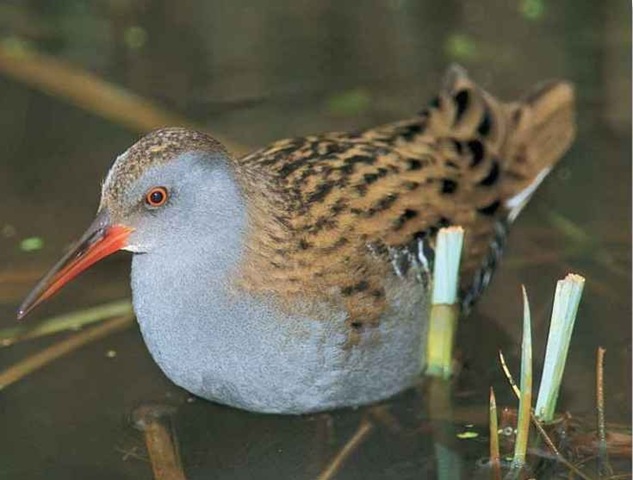ORDER
Gruiformes
FAMILY
Rallidae
GENUS & SPECIES
KEY FEATURES
Stays undercover in marshland grasses, and is rarely seen but often heard grunting as it feeds Prefers not to fly and eats plants or animals in the water or on land
Leaves the nest within hours of birth, but follows its parents, which feed and protect it
WHERE IN THE WORLD?
Widespread in marshes across Asia and Europe, with a breeding range from iceland to Japan, including Russia and the Mediterranean

LIFECYCLE
Even the avid birdwatcher often fails to spot the reclusive water rail, which leaves the nest immediately after birth to lead an undercover life in the marsh.
HABITAT
The water rail is far-reaching throughout Europe and Asia. Within its range, it will call any marsh, freshwater swamp or bog home. It regularly uses paths cut through the dense vegetation to connect feeding areas. During icy winters, some nonmigratory rails simply settle on the shores of channels, swamps, lakes and ponds.Those in Iceland take advantage of hot springs with warm streams that melt through the snow. Water rails that do migrate prefer spending their winters in the warm climates of the Mediterranean and southern Asia.
Reserved rail A water rail offers a glimpse of itself before slipping back into cover.
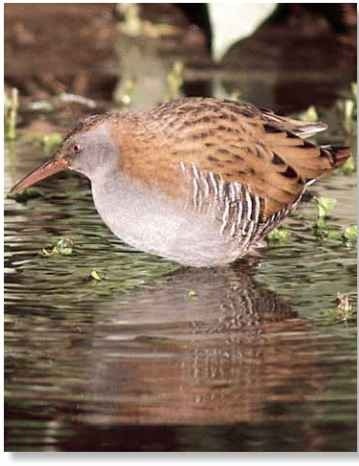
FOOD & FEEDING
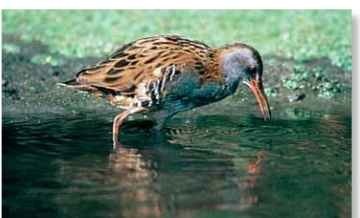
The water rail is an opportunistic feeder and rarely passes up an opportunity to eat any plant or animal found in its marshy habitat. The water rail probes for shrimp, small fish and snails in the water, but also forages along the banks for insects, worms, seeds and berries. Rarely seen during the warmer seasons, it can easily be spotted in the winter when it must venture out to reach food under unfrozen water surfaces.
THE RAIL-ROAD
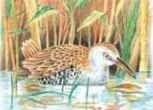
Swimming…
A secretive water rail embarks from its tall, grassy hideaway to paddle along the marsh in search
of aquatic food.

Striking…
Within minutes the rail, using i slender bill, launches a swift an precise attack on a frog that’s caught off guard.
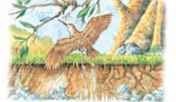
Jumping…
Upon detecting a dragonfly that has just settled on a bulrush, the water rail leaps from the water 3′ into the air.
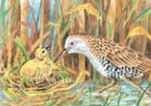
Stabbing
The rail takes a shortcut through the tall grasses and encounters the perfect prey an unprotected nestling.
CONSERVATION
Water rail populations remain strong, but draining swamps and cleaning overgrown ponds have taken a toll. Only about 3,500 California black rails, a cousin of the water rail, still survive. Conservationists are lobbying to have this rail included on the federal list of endangered species.The water rail can fly weakly to avoid land predators, but many island rails are flightless and are extremely vulnerable to predators such as cats and rats.
The rail, which has an extremely slender body, probably inspired the expression “skinny as a rail.”
The water rail performs distraction displays, such as pretending to be hurt, to lure disturbing intruders away from its nest.
The rail’s wings have a small claw where the wing bends. The rail actually has 3 fingers in its wing and this claw is the equivalent of a human’s thumb. The rail moves through dense-growing plants by hooking and pushing them to the side with its claw and wing.
BREEDING
Either sex initiates courtship by rubbing bills or by preening, which helps establish mutual trust. The male often performs an unusual display:it flaps its tail, raises its wings and rests its bill against the female rail, then encircles her while showing off his feathers.
The large, cup-shaped nest is well hidden and rests at or near water level. Both parents share incubation; when the young start hatching, the parents pick off the eggshell. The chicks follow their parents within hours of hatching. This way, the parents don’t have to return to the nest with food after foraging; they just feed the chicks where the food is found. Within a few weeks, the chicks can find food by themselves and take their first flying lessons by the time they’re 2 months old.
One of nine Chicks leave the nest hours after they hatch.
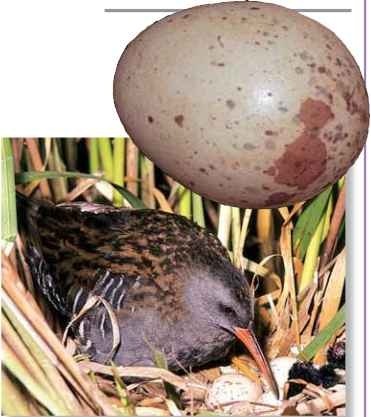
A A little help from mom wouldn’t hurt Water rail chicks hatch with their eyes open and a coat of soft, black down; the female picks off the eggshells.
BEHAVIOR
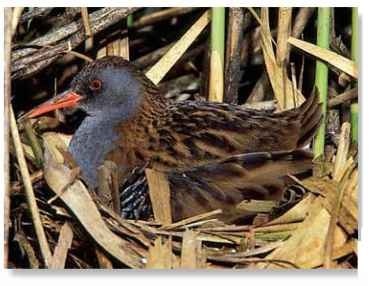
A shy, secretive bird that usually withdraws into the dense grasses for protection, the water rail is often heard but not seen as it grunts softly, sounding much like a pig, while looking for food.
The water rail is a very wary bird; when it feels threatened, it will stand completely still or run for cover: It prefers not to fly, so it will only do so as a last resort.
Master of the marsh The rail can dart easily through the grass for cover.
PROFILE
Water Rail
The slender water rail maneuvers expertly with its long legs through tangled marshland grasses and across mud flats.
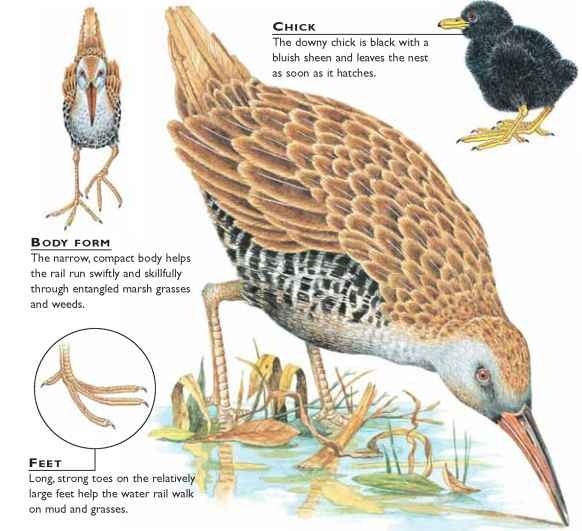
CREATURE COMPARISONS
The Inaccessible Island rail is found only on Inaccessible Island, located fc^^ in the Tristan da Cunha Islands in the south Atlantic Ocean. Measuring 5″ in length, this rail is the smallest flightless bird and is much smaller than the water rail. Sometimes called the
island hen, this primarily dark, reddish-brown and gray bird is plainer than the water rail. Both rails search for insects among tangled grasses.The Inaccessible Island rail weaves grasses into an unusual-looking nest; it has a roof formed from matted tussocks. It lays a much smaller clutch of only two eggs on Inaccessible Island rail the relatively predator-free Inaccessible Island.
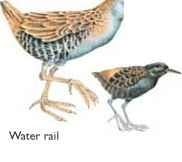
| VITAL Weight |
STATISTICS 4.5-6.5 lbs. |
| Length | 11″ |
| Sexual Maturity | 1 year |
| Breeding Season | April-July |
| Number of Eggs | Average of 6-11 |
| Incubation Period | 20-30 days |
| Fledging Period | 7-8 weeks |
| Breeding Interval | Up to two broods per year |
| Typical Diet | Mollusks, insects, seeds and vegetation |
| Lifespan | 6 years |
Related species
• The genus Rallus includes the California clapper rail, Rallus longirostris obsoletus, as well as the water rail, R. aquaticus. There are over 120 species in the family Rallidae, which consists of rails, coots, crakes and gallinules. Coots, with their lobed feet, are the most aquatic birds in the group. Long bills distinguish rails from the stubbier-billed crakes.
